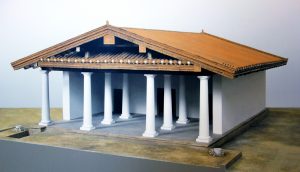23 Chapter 6.2: Etruscan Temples, Sculpture, and Jewelry
ETRUSCAN TEMPLES
Like the Greeks the Etruscans built majestic temples for their deities. Considered houses for the gods and goddesses they housed statues of them. We study Etruscan temples from models, since none survive. Fortunately, the Roman architect Vitruvius provided detailed descriptions of their appearance. Additionally, some information can be gleaned by their foundations, which were made of more permanent materials. While at first glance they may appear to resemble Greek temple architecture closely, there are some significant differences.

Etruscan Temples TASK
The videos below introduce the basic features of the Etruscan temple, describing their layout, materials, and distinctive features. After viewing the videos, please respond to the following questions.
Art History: We Learn Etruscan Temple
Etruscan Temples
Etruscan Temples TASK prompts:
What are the two main parts of the Etruscan temple and what do each consist of?
Why are there several cellas?
What material were the different parts of the temple made of?
What influenced their choice of materials?
On what did the temple rest and how was it accessed?
How was the roof decorated?
How do they differ from Greek temples?
ETRUSCAN SCULPTURE
The Etruscans created large scale sculptures in bronze and terracotta and were masters at these materials. The videos in this section introduce some of the most famous examples of Etruscan function, discussing their style, technique, and function.
Bonze statuette of a young woman, Etruscan, late 6th century B.C.E. Metropolitan Museum of Art. Public Domain.
Estruscan Sculpture TASK 1
Apulu (Apollo of Veii)
Estruscan Sculpture TASK prompt:
What was this sculpture’s original location and how did it function in that context?
What are the distinctive traits of this sculpture?
How does it compare to Greek Archaic art?
Etruscan Sculpture TASK 2
Sarcophagus of the Spouses (Rome)
Etruscan Sculpture TASK 2 prompts:
What are the distinctive stylistic qualities of the figures?
How do the figures compart to Greek Archaic art?
What technique was used to create such a large terracotta work?
What were they holding?
Where was this originally located?
ETRUSCAN JEWELRY
The various videos emphasized the importance of metals to the Etruscan economy and the arts. Etruscan artists were highly skilled metalsmiths, creating large scale bronze sculptures and small, ornate pieces of jewelry. The techniques employed in making jewelry reflect a knowledge of the Near East.
Etruscan Jewelry TASK
Like ancient Egyptian tombs, Etruscan tombs were frequently plundered. When discovered the Regolini-Galassi tomb retained its original treasures and provided valuable information on the content of Etruscan tombs. The short essay below highlights one of the most extraordinary objects from the tomb, the Parade fibula. After reading the essay, please respond to the accompanying question.
The Regolini-Galassi tomb and the Parade fibula
Etruscan Jewelry TASK prompt:
What techniques were used to create the Parade fibula and where did they originate?
What three parts comprise the work?
What motifs reference the afterlife?
What refers to royalty?
What does this communicate about Etruscan elites?

